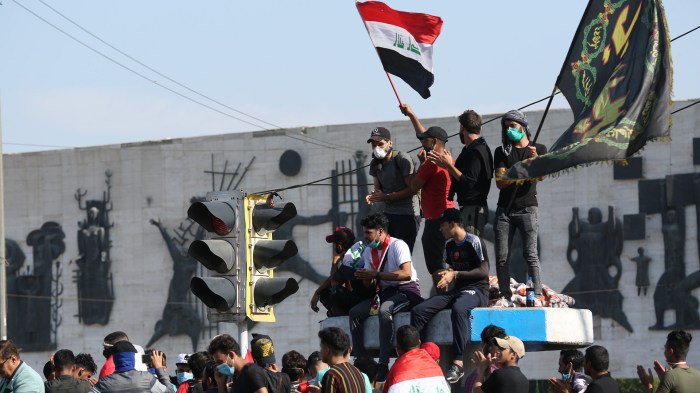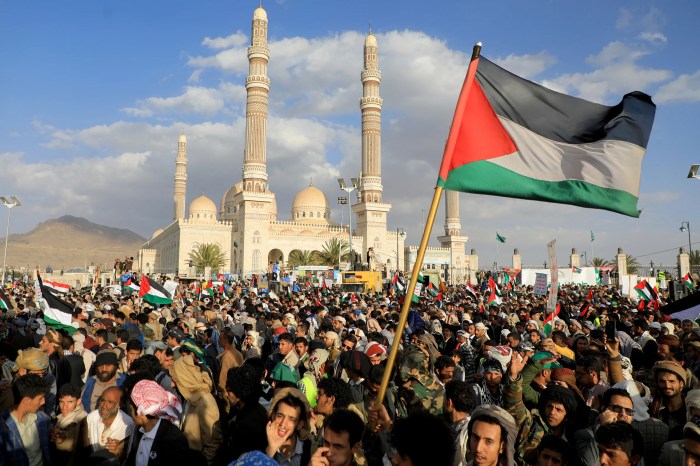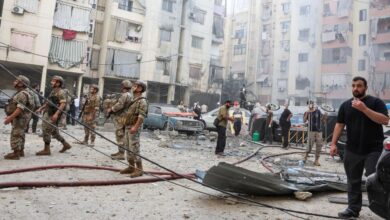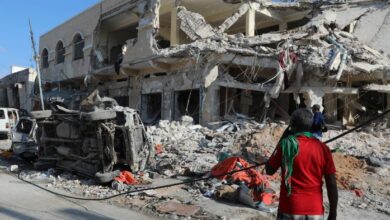
Mideast North Africa Unrest: A Complex History
Mideast North Africa unrest is a multifaceted issue with deep roots in history, politics, economics, and social dynamics. From the Arab Spring uprisings to ongoing conflicts, the region has experienced a turbulent period marked by both hope and despair. This unrest is not simply a recent phenomenon but a complex tapestry woven from centuries of colonial influence, political instability, and economic inequality.
Understanding the factors that contribute to unrest in the Mideast and North Africa requires a nuanced perspective that considers the interconnectedness of historical, political, economic, and social factors. By examining the interplay of these forces, we can gain a deeper understanding of the challenges and opportunities facing the region as it navigates a path toward peace and stability.
Historical Context
The Middle East and North Africa (MENA) region has a long and complex history, marked by periods of both stability and upheaval. Understanding this history is crucial to grasping the root causes of the unrest that has plagued the region in recent decades.
Impact of Colonialism
Colonialism played a significant role in shaping the political and economic landscape of the MENA region. European powers, primarily Britain and France, carved up the region into various colonies during the 19th and early 20th centuries. These colonial powers imposed their own systems of governance, education, and economic development, often neglecting the needs and aspirations of the local populations.
- Artificial Borders:Colonial powers drew arbitrary borders that often ignored existing ethnic and tribal divisions, leading to long-standing tensions and conflicts.
- Exploitation of Resources:Colonial powers extracted vast amounts of natural resources from the region, enriching themselves while leaving behind underdeveloped economies and infrastructure.
- Suppression of Nationalism:Colonial regimes suppressed nationalist movements and movements for self-determination, leading to resentment and a desire for independence.
The legacy of colonialism continues to have a profound impact on the MENA region. The arbitrary borders created by colonial powers have contributed to ongoing conflicts and instability. The economic structures imposed by colonial regimes have left many countries in the region dependent on foreign aid and investment.
The suppression of nationalist movements has created a climate of mistrust between governments and their citizens.
Political Factors

The political landscape of the Middle East and North Africa (MENA) has been a major contributing factor to the unrest in the region. The complex interplay of authoritarian regimes, corruption, human rights violations, and international actors has fueled social and political tensions, leading to widespread protests and uprisings.
Authoritarian Regimes and Their Impact
Authoritarian regimes have been prevalent in the MENA region for decades, characterized by limited political freedoms, suppression of dissent, and a concentration of power in the hands of a few. These regimes often use repressive measures to maintain control, including censorship, arbitrary arrests, and the use of violence against opposition groups.
The lack of democratic institutions and processes has created a climate of frustration and resentment among the population, leading to a desire for change.
- Examples:The regimes of Muammar Gaddafi in Libya, Hosni Mubarak in Egypt, and Bashar al-Assad in Syria were all characterized by authoritarian rule and a lack of political freedoms. These regimes faced widespread protests and uprisings in the Arab Spring, leading to regime change in some cases and ongoing conflicts in others.
Corruption and Its Role in Unrest
Corruption is endemic in many MENA countries, undermining trust in government institutions and exacerbating social inequalities. The misuse of public funds, nepotism, and the lack of accountability create a sense of injustice and resentment among the population. Corruption also hinders economic development and creates opportunities for criminal activities, further fueling unrest.
- Examples:The widespread corruption in countries like Iraq, Yemen, and Lebanon has contributed to a lack of basic services, economic stagnation, and social unrest. The perception of corruption has eroded public trust in governments and fueled protests demanding accountability and reform.
Human Rights Violations and Their Consequences
Human rights violations, including arbitrary detention, torture, and the suppression of freedom of speech and assembly, are widespread in many MENA countries. These violations contribute to a climate of fear and repression, hindering the development of a vibrant civil society and democratic institutions.
The unrest in the Middle East and North Africa has highlighted the need for sustainable development solutions. Many non-governmental organizations are working tirelessly to address these issues, focusing on areas like education, healthcare, and economic empowerment. Learn more about the vital role these organizations play in fostering development and promoting stability in the region.
The lack of accountability for human rights abuses further fuels resentment and anger among the population.
- Examples:The crackdown on peaceful protests in Bahrain, the systematic use of torture in Egypt, and the persecution of minorities in Saudi Arabia have all contributed to the unrest in the region. The lack of justice and accountability for these violations has exacerbated the anger and frustration of the population.
The unrest in the Middle East and North Africa has had a profound impact on the region, with political and economic instability creating a challenging environment for trade. However, amidst the turmoil, some countries have sought to foster economic cooperation through initiatives like some regional free trade agreements.
These agreements aim to promote regional integration, reduce trade barriers, and create a more stable economic landscape, which could ultimately contribute to resolving some of the underlying causes of the unrest.
Role of International Actors
International actors, including regional powers, global organizations, and individual countries, have played a significant role in shaping the political landscape of the MENA region. Their policies, interventions, and support for particular regimes have often had a profound impact on the region’s stability and the outbreak of unrest.
- Examples:The US intervention in Iraq, the French military intervention in Libya, and the involvement of regional powers like Saudi Arabia and Iran in the Syrian civil war have all contributed to the complex and volatile political situation in the region.
The actions of international actors have often been seen as contributing to instability and exacerbating existing tensions.
Economic Factors
The Middle East and North Africa (MENA) region has been grappling with a range of economic challenges that have contributed to social unrest and political instability. These challenges are multifaceted, encompassing issues of poverty, unemployment, and resource scarcity, all exacerbated by the impact of globalization and foreign investment.
This section delves into the economic factors that have fueled unrest in the region.
Poverty and Unemployment
Poverty and unemployment are significant drivers of social unrest in the MENA region. The region has a high poverty rate, with approximately 20% of the population living below the poverty line. This is partly due to a lack of economic diversification, with many countries heavily reliant on oil and gas exports.
The fluctuating prices of these commodities have made economies vulnerable to shocks, leading to periods of economic hardship. Moreover, the region faces a youth bulge, with a large proportion of the population under the age of 30. This has led to high unemployment rates, particularly among young people, further exacerbating economic frustration and fueling social unrest.
Resource Scarcity
Resource scarcity, particularly water, is another major economic challenge facing the MENA region. The region is characterized by arid and semi-arid climates, making water a scarce and precious resource. Water scarcity has implications for agriculture, industry, and domestic consumption, leading to competition for resources and potential conflicts.
This is further compounded by population growth and urbanization, which place increasing pressure on water resources.
Globalization and Foreign Investment
Globalization and foreign investment have had a mixed impact on the MENA region’s economies. While these forces have brought opportunities for economic growth and development, they have also contributed to economic inequality and social injustice. Foreign investment has often been concentrated in specific sectors, such as oil and gas, leaving other sectors underdeveloped.
Moreover, globalization has led to increased competition from low-wage economies, putting pressure on local businesses and workers.
The Middle East and North Africa have been plagued by unrest for decades, often fueled by a sense of disillusionment and frustration. This unrest is further exacerbated by the wasted wealth, capital, labor, and resources that are often found in these regions, leading to a vicious cycle of poverty, inequality, and instability.
While some progress has been made in addressing these issues, much work remains to be done to achieve lasting peace and prosperity in the region.
Economic Inequality and Social Injustice
Economic inequality and social injustice are deeply rooted in the MENA region and have contributed to the unrest. The region has some of the highest levels of income inequality in the world, with a small elite controlling a disproportionate share of wealth.
This inequality has led to widespread resentment and frustration, particularly among the young and unemployed, who feel excluded from the benefits of economic growth. Moreover, social injustice, such as discrimination based on religion, ethnicity, or gender, has further exacerbated tensions and fueled unrest.
Social Factors
The Middle East and North Africa (MENA) region is characterized by a diverse tapestry of social and cultural factors that often contribute to unrest. These factors, including ethnic tensions, religious differences, and gender inequality, interact with political and economic dynamics, creating a complex and often volatile landscape.
The Role of Ethnic Tensions
Ethnic tensions play a significant role in shaping the social landscape of the MENA region. The region is home to a diverse range of ethnic groups, each with its own unique history, culture, and identity. These groups often compete for resources, power, and political influence, leading to tensions and conflict.
In some cases, these tensions have been exacerbated by historical grievances, discriminatory policies, and the perception of marginalization.
- The Kurdish Question:The Kurds, an ethnic group with a large population in Turkey, Iraq, Iran, and Syria, have long sought autonomy or independence. Their struggle for self-determination has been a source of tension and conflict in the region, particularly in Turkey and Iraq.
- The Arab-Berber Divide:In North Africa, the Arab-Berber divide has been a source of tension and conflict for centuries. The Berbers, an indigenous North African group, have often felt marginalized by Arab rule, leading to protests and unrest.
The Impact of Religious Differences
Religious differences are another significant factor contributing to unrest in the MENA region. The region is predominantly Muslim, but it is also home to significant Christian, Jewish, and other religious minorities. These religious differences have often been exploited by political leaders to divide and conquer, leading to tensions and conflict.
- Sectarian Violence:In Iraq, Syria, and Lebanon, sectarian violence between Sunni and Shia Muslims has been a major source of instability. These tensions have been exacerbated by the rise of extremist groups such as ISIS, which have exploited sectarian divisions to advance their own agendas.
- Religious Persecution:Religious minorities in the MENA region have often been subject to persecution and discrimination. In some countries, such as Saudi Arabia and Iran, religious freedom is severely restricted. This persecution has led to unrest and protests by minority groups seeking equal rights and protection.
Gender Inequality
Gender inequality is a pervasive problem in the MENA region, with women often facing discrimination and limited opportunities. This inequality can contribute to unrest by fueling social and political tensions. Women in the region are often denied basic rights, such as the right to education, employment, and political participation.
They are also frequently subject to violence, both within the home and in public spaces. These injustices have led to protests and movements demanding gender equality and women’s rights.
- Women’s Rights Movements:In recent years, there has been a growing movement for women’s rights in the MENA region. These movements have organized protests and demonstrations, demanding an end to discrimination and violence against women. They have also been active in promoting women’s education, employment, and political participation.
- The Role of Social Media:Social media has played a significant role in empowering women’s rights movements in the MENA region. Women have used social media platforms to share their experiences, organize protests, and raise awareness of gender inequality. Social media has also provided a platform for women to connect with each other and build solidarity.
Security and Conflict

The Middle East and North Africa (MENA) region is characterized by a complex interplay of security and conflict. The region’s history, political landscape, and economic disparities have contributed to a volatile security environment, often marked by internal conflicts, regional tensions, and the rise of terrorism.
The Role of Security Forces
Security forces in the MENA region play a crucial role in maintaining order and stability. However, their actions have often been a source of contention, contributing to unrest and exacerbating existing tensions.
- In many countries, security forces have been accused of human rights abuses, including arbitrary arrests, torture, and extrajudicial killings. These practices have alienated populations and fueled anti-government sentiment.
- The use of excessive force to quell protests and dissent has further exacerbated tensions and contributed to the cycle of violence.
- The lack of accountability and transparency within security forces has eroded public trust and contributed to a climate of fear and insecurity.
Dynamics of Conflict and Violence
The MENA region has been plagued by a multitude of conflicts, ranging from civil wars and interstate disputes to sectarian violence and ethnic clashes. These conflicts have had a devastating impact on the region’s stability and development.
- The Arab Spring uprisings, which began in 2011, led to regime change in several countries, but also triggered protracted civil wars in Libya, Syria, and Yemen.
- The rise of sectarianism and religious extremism has fueled violence in countries like Iraq, Syria, and Lebanon.
- The ongoing conflict in Israel and Palestine continues to be a major source of instability and tension in the region.
Impact of Terrorism and Organized Crime
The MENA region has become a breeding ground for terrorism and organized crime, posing a significant threat to regional and global security.
- Groups like al-Qaeda and ISIS have exploited the region’s instability to gain a foothold and carry out attacks, both within the region and beyond.
- Organized crime networks are involved in human trafficking, drug smuggling, and arms dealing, undermining the rule of law and exacerbating corruption.
- The presence of terrorist and criminal organizations has destabilized economies, hindered development, and forced governments to allocate resources to security rather than social and economic programs.
Responses to Unrest: Mideast North Africa Unrest
The response to unrest in the Middle East and North Africa (MENA) region has been diverse and complex, reflecting the multifaceted nature of the uprisings and the unique circumstances of each country. Governments have implemented a range of strategies, from brutal crackdowns to more moderate reforms, while international actors have also played a significant role.
This section explores the different responses to unrest, analyzes their effectiveness, and examines the outcomes of various approaches.
Government Crackdowns
Government crackdowns have been a common response to unrest in the MENA region. These strategies often involve the use of force, including the deployment of security forces, the imposition of curfews, and the suppression of dissent. In some cases, governments have also resorted to mass arrests, torture, and extrajudicial killings.While government crackdowns may be effective in quelling unrest in the short term, they often exacerbate tensions and fuel further instability.
By suppressing dissent, governments create a climate of fear and distrust, which can lead to more radicalization and violence. Moreover, crackdowns often fail to address the root causes of unrest, such as economic inequality, political repression, and social injustice.Examples of government crackdowns include:
- The Syrian government’s brutal crackdown on protests in 2011, which triggered a devastating civil war.
- The Egyptian government’s violent suppression of protests in 2013, which resulted in the overthrow of democratically elected President Mohamed Morsi.
- The Bahraini government’s use of force to quell protests in 2011, which led to the imposition of a state of emergency and the arrest of hundreds of protesters.
Political Reforms, Mideast north africa unrest
In response to the unrest, some governments in the MENA region have implemented political reforms aimed at addressing grievances and promoting democracy. These reforms have included measures such as:
- Constitutional amendments to expand political freedoms and strengthen democratic institutions.
- The establishment of independent electoral commissions and judiciaries.
- The introduction of multi-party systems and free and fair elections.
- The lifting of restrictions on freedom of speech, assembly, and the press.
Political reforms have been more successful in some countries than others. For example, Tunisia has made significant progress in transitioning to democracy, while Libya has struggled with instability and violence following the overthrow of Muammar Gaddafi. The effectiveness of political reforms depends on a number of factors, including the commitment of the government, the strength of civil society, and the willingness of the international community to provide support.
International Interventions
International actors have played a significant role in the response to unrest in the MENA region. These interventions have taken a variety of forms, including:
- The imposition of sanctions to pressure governments to reform.
- The deployment of peacekeeping forces to stabilize conflict zones.
- The provision of humanitarian aid to address the needs of displaced populations.
- The support for democratic transitions through technical assistance and capacity building.
International interventions have had mixed results. While some interventions have helped to promote stability and democracy, others have been criticized for exacerbating conflicts or undermining local governance. The effectiveness of international interventions depends on a number of factors, including the goals of the intervention, the political context, and the coordination among international actors.
Outcomes of Different Responses
The outcomes of different responses to unrest in the MENA region have been varied. In some cases, government crackdowns have been successful in suppressing unrest in the short term, but they have often led to long-term instability and violence. In other cases, political reforms have led to a transition to democracy, but this process has often been slow and challenging.
International interventions have also had mixed results, with some interventions helping to promote stability and democracy, while others have exacerbated conflicts or undermined local governance.The following table provides a summary of the outcomes of different responses to unrest in the MENA region:






